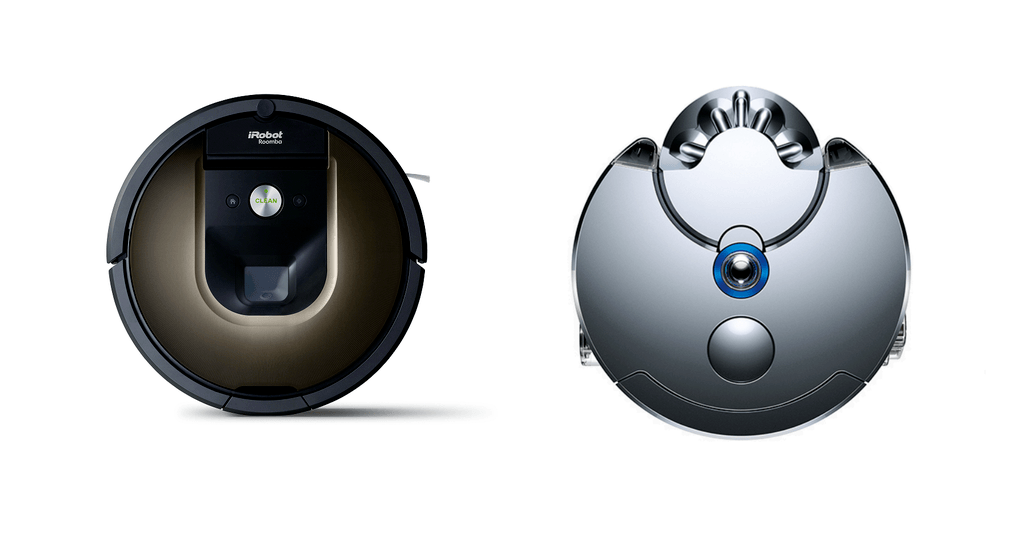So you like to be on the bleeding edge of technology and you want an autonomous robotic vacuum to help keep your floors clean. You have no doubt heard of the industry leader iRobot and their small army of Roomba vacs.
But you know Dyson has arguably the best upright vacuums on the market and they now, too, have a robotic floor vac: The Dyson 360 Eye. So how does it stack up against the Roomba 980? Let’s toss out the price tag, because at this point that doesn’t matter.
Performance, navigation, cleaning power, intelligence, maintenance; these things matter. In this article, I will compare the Dyson 360 Eye against the Roomba 980 in a side-by-side comparison. I will look at the differences and similarities, the features and options, the pros and cons, and I will answer a few common questions.
Continue to the entire article below to see the round by round battle of these two machines. However, if you just stopped by to get my opinion: The Roomba 980 is still the king of the robotic vacuum underground battlefield; a.k.a. Your living room floor.
Contents
The Differences Matter
- Height. The Roomba is over one full inch shorter than the Dyson giant.
- The 360 Eye vacuums in a grid pattern, the 980 goes in human-like parallel lines.
- The Dyson collection bin is almost half the size of the iRobot bin.
- The Roomba has side brushes; the 360 Eye has a full-width brush bar.
- The Roomba 980 utilizes tangle-free brushless extractors; the 360 Eye has brush filled rotating bars.
- Battery life of the Dyson beast is a mere 45 minutes, where the Roomba monster is around two hours.
- The 360 Eye has tank treads where the Roomba uses castor wheels.
- The 980 has carpet boost to increase power over carpet. The 360 Eye has a high powered motor always at high speed.
- Dyson does not offer HEPA filters for the 360 Eye; the Roomba 980 requires HEPA filtration.
Sometimes Similarities Make the Difference

- Both combatants use visual sensors for mapping and navigation.
- Each of the robots is able to have cleaning cycles scheduled.
- The 360 Eye and the 980 both have rechargeable lithium-ion batteries.
- Both models can auto-dock for recharging.
- They both have drop sensors to prevent falling off stairs or ledges.
- Both autonomous vacs are rated to clean all floor types.
- Each robotic vacuum uses a mobile app for control.
- You can use voice controls with Amazon Alexa on the Roomba 980 and the 360 Eye.
The Side-by-Side Comparison Chart
| Roomba 980 | Dyson 360 Eye | |
| Battery Type | Lithium-Ion | Lithium-Ion |
| Battery Life | Up to 2 hours | Up to 45 Minutes |
| Recharge Time | 180 minutes | 165 Minutes |
| Floor Types | All | All |
| Navigation and Mapping | iAdapt 2.0 | 360 Degree Vision System |
| Scheduled Cleaning | Yes | Yes |
| Extractors | Tangle-free, brushless | Bristled bars, Nylon for carpet Carbon fiber for hard floors |
| Drop Sensors | Yes | Yes |
| Dirt Detection Sensors | Yes | No |
| Collision Sensors | Yes | No |
| Side Brushes | Yes | Replaced with Full-width bars |
| Mobile App | iHome | Dyson Link |
| Virtual Wall Barriers | Yes | No |
| Weight (rounded up) | 9 pounds | 6 pounds |
| Height | 3.6 inches | 4.72 inches |
| Price | Check on Amazon | Check on Amazon |
Features and Options Details
I want to dive into the features and options of these two machines in greater detail. You can thank me later.
1. Batteries
Even robots need a power source. Lithium-ion is the reigning champion of rechargeable, long lasting batteries and both the Roomba 980 and the 360 Eye use them. How they use them is a different story.
The Dyson vacuum has a high powered motor that only has one speed: suck up everything. The video camera that maps and navigates also uses a lot of battery power. When the battery is completely dead, a full charge will take just about 2 and a half hours. From that full charge, you will get about 45 minutes of run time.
On most floors with a simple and open layout, this 45 minutes should be plenty. However, the vacuum goes in ten-foot grid areas to cover the floor, ensuring it covers every possible square foot. If you have a complex floor plan or have a lot of furniture, the grids will get interrupted, and the robot will have to find a new route.
The Roomba 980 also has a high powered motor that comes in two speeds: normal suction mode and carpet boost. When going over a carpet, the motor is revved up to create more suction power and drains the battery faster. It also has edge cleaning mode which is a slower, more methodical pass of your baseboards and area edges, draining more battery.
The parallel line formation of the vacuum lines is meant to behave more like a human would vacuum and reduces the need for alternate routes. When it comes to an obstacle or furniture is just goes around, not needed to find as many alternate routes.
A full charge from a dead battery will take three hours on a 980; however, you will get 2 hours (under optimal conditions) of run time. In a real-world test, the charge lasts about an hour and a half, which is still twice as long as the Dyson.
Bottom Line: The Roomba 980 wins. A slightly longer charge time isn’t as crucial as having more area cleaned in a shorter time.
Back in the old days when we were all young children (2002 – 2014), robot vacuums relied on audio and touch-sensitive sensors to detect objects and obstacles. Now we are all grown up and expect more from our robots. Video cameras and visual sensors, to be exact.
The Roomba 980 has a top mount video camera that allows it to map the cleaning area with a visual map. The iAdapt 2.0 technology stores this map rendering in the robot’s memory to allow it to clean more efficiently. It will note furniture location, obstacles and drops, ledges and stairs and remember their location for the next cleaning cycle.
If you happen to rearrange your furniture or add new obstacles, the Roomba 980 will probably bump into them once. It will then erase the stored map and create a new one.
The Dyson 360 Eye also uses a top mount camera for mapping and navigation. The main difference is that unlike the forward facing camera of the 980, the 360 Eye looks around 360 degrees (hence the name) at all times, constantly updating the map and navigation modules in the robot’s computer.

As it cleans, it will update where it has been, what areas still need to be cleaned and how far along the grid it is. Moving furniture doesn’t matter, as the map is constantly being updated on every cleaning cycle. Even if you relocated the vacuum and charging station prior to the next cleaning cycle, there wouldn’t be many issues in navigation.
Bottom Line: The 360 Eye wins. Dyson technology makes mapping and navigation a bit more seamless, albeit slightly.
3. Sensors
Aside from the visual navigation sensors, there are also other sensors in use by both robotic vacuums. Touch sensors and drop sensors are the most common.
The Dyson has a drop sensor to prevent it from falling off ledges or tumbling down stairs. Any drop greater than 3 inches is avoided. While dark colors on carpet or tile flooring can confuse the sensors, it is less likely to avoid false drops like the Roomba 980 is prone to do.
The 360 Degree Vision System of the Dyson model keeps the robot from banging into walls and obstacles.
The Roomba also has drop detection sensors that prevent it from falling off stairs or ledges. It has been known to avoid flat surfaces if they are too dark. This is generally when dark carpet has stark contrasts between light and dark, or tile floors are black and white.
The 980 also has touch sensors to prevent it from colliding with obstacles and furniture. If a collision is detected, it will reverse and go around the obstacle without causing damage. Also added are dirt detection sensors that ensure the area being cleaned are actually free of dirt and debris.
One other added feature is a Virtual Wall Barrier. These battery operated towers will send an infrared signal that creates an invisible barrier your vacuum will not cross. You can set it in doorways to prevent access to a room or area, or turn on radius mode to surround items such as pet food bowls and easily knocked over items.
Bottom Line: The Roomba 980 wins. Extra sensors are always a good thing, and the Roomba just plain has more of them.
4. Extractors and Brushes
Lifting dirt and debris into the vacuum chamber to be collected by the bin is the one thing a vacuum has to do. It doesn’t matter how powerful the motor is or how large the collection bin is if you don’t have extractor bars the dirt will never leave the floor.
The Roomba 980 uses dual, counter-rotating extractor bars. They got rid of the brushes and bristles and utilized interlocking grooves in their place. iRobot claims the extractors are tangle free. There is also a sensor in the extraction chamber to note if the bars are caught on something like a cord or wire.
In this instance, the Roomba 980 will reverse the bars and attempt to free itself. If successful it will go around the cord to prevent being tangled again. Tangle-free in this instance does not mean free from hairs or strings.
Just like anything that rotates on the floors, it will collect longer hairs and threads that will get wrapped around the extractors. The good news is that the extractors are easily removable and without brushes and bristles to get in the way they wipe off easily.
The 980 also uses two side brushes that rotate to push dirt and debris to the center of the cleaning path.
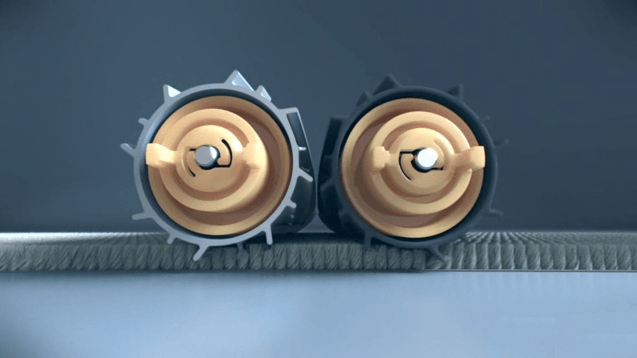
The 360 Eye has one full-length bar that combines nylon bristles with carbon fiber brushes for cleaning on all floor types. The bar replaces the need for side brushes as it is the entire width of the machine.
With only one bar rotating the tangles are inevitable. The cross angles bristles pick up most hair and fur and stings, but it is easily wrapped around the extractor bar. The only downside to this is that the extractor bar is not the easiest to remove. Cleaning and maintenance are much like a standard upright and can take quite a bit of time and effort.
While the brush bar does go the entire width of the machine, it does not extend past it. Debris along edges and especially in corners is easily missed.
Bottom Line: The Roomba 980 wins this battle. The extractors don’t miss much and what is missed is collected by the side brushes and pushed to the extractors. Clean up is faster and easier as well.
5. Mobile Apps
Both iRobot and Dyson have mobile apps for their robotic vacuums. Connecting your smart home to your vacuum has never been easier. Full control and scheduling from virtually anywhere.
The Roomba 980 uses the iHome mobile app on any Android or iOS device. The app is a free download and is not essential for using the vacuum; however, it is a lot easier. Once downloaded you just need to sync your robot to the network and then your network to the app.
From there you can name your robot, create and delete schedules, see reports on cleaning cycles, start, stop, pause or continue cleanings and see reports on battery life and charging times.
Dyson Link is the Android and iOS mobile app that connects to the 360 Eye. Much the same as the iHome app, you can take full control of the robot vacuum. However, the Dyson app isn’t very intuitive. I found the app clumsy to set up and sync with the network and robot. Once I finally figured it out, the start clean was simple enough, however creating and editing schedules was a chore.
Once I learned how to do everything in the app, I still had trouble getting most things going. A few too many steps involved, unless you just want to start cleaning. The reports were the same as the Roomba, with coverage, battery and charging times. However, the grid pattern layout was confusing at first.
Overall the apps are far better than leaning over to press a physical button on the machines, and the ability to use them from anywhere makes them invaluable. I know for myself, I wasn’t always home when I needed to have a quick vacuum done.
Bottom Line: The Roomba 980 wins this round, barely. The app is a lot easier to use and is quite intuitive, but they accomplish the same tasks.
6. Voice Controls
Not autonomous smart home would be complete without the ability to give voice commands to your vacuum. George Jetson had Rosie; we have Dyson and Roomba.
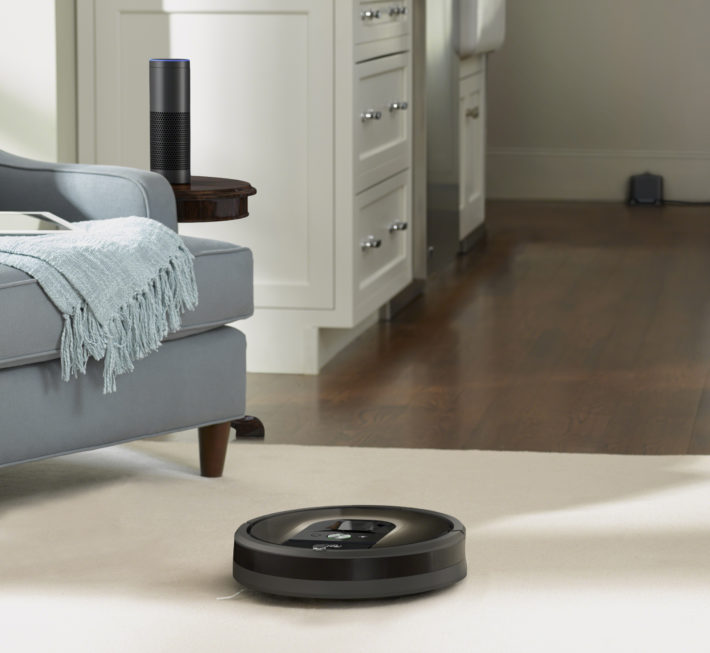
The ability to sync your machine to Amazon Alexa allows you to throw out voice commands to not only clean but to get crucial information such as troubleshooting, status and battery life.
With the Roomba 980 and Amazon Echo, you can start, stop, pause and resume cleanings just by using your voice. You can also make the robot return to the docking station, find out where it is in the home and get other updates.
The 360 Eye also allows you to use Alexa commands to start cleaning, get status reports, and you can even find out more details about the features of the vacuum. Advice, tips, and troubleshooting are all just a voice call away.
Bottom Line: This round is a tie. Amazon Alexa controls work with both models.
7. Cameras
The cameras on these two vacuums set them apart from all the rest. However, they both work in different ways.
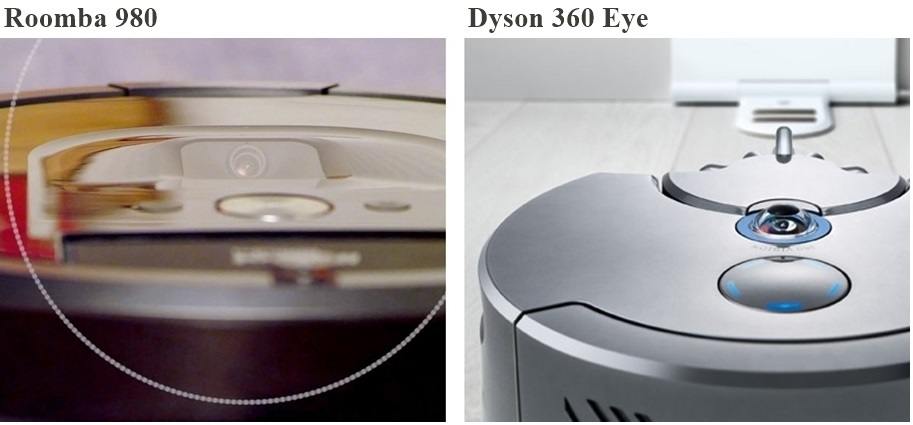
In the Dyson 360 Eye, the camera is always on. It takes 30 images per second to get the current layout of the space and then creates a panoramic view to follow. It will figure out a few stationary points, such as a chair or table, and then use those points to triangulate its position.
From there it will begin cleaning, constantly updating the created image and triangulation to know where it has been, what areas need to be cleaned and how much is remaining. The images is sliced into grids measuring about ten feet in size that the robot will circle through to clean that grid area before moving on to the next.
By updating every second, the robot has fewer collisions with objects and furniture.
The Roomba Camera doesn’t work in the same manner. It will take visual cues from the camera to create a map of the cleaning area. This map is then stored in memory as a roadmap guide for where it needs to clean.
The Roomba relies on acoustic and bottom sensors to locate objects, so if you move things around it may collide with them until it remaps the area. The map is highly accurate though, and as long as no new objects are introduced to the area, you will see fewer and fewer collisions with each cycle.
Touch sensors allow it to reverse and go around obstacles and drop sensors keep it on level floors.
Bottom Line: The Dyson has another slight advantage win. The constant update prevents more collisions than that of the Roomba, which is still small in number.
8. Tank Tracks and Tires
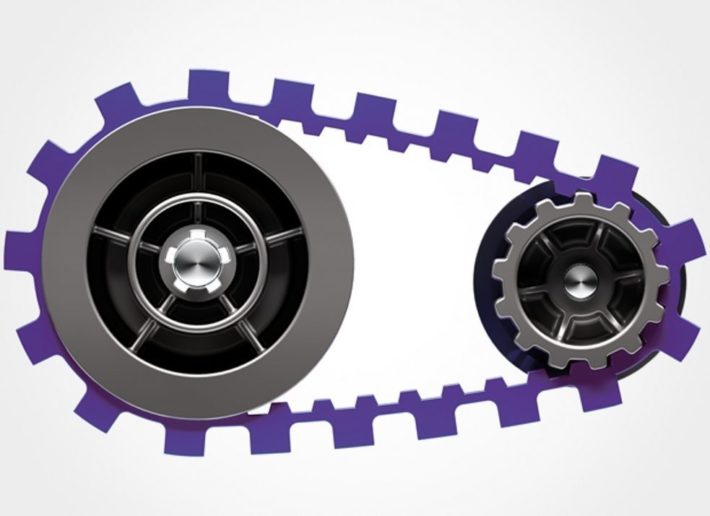
If the robot can’t move over your floor, then it wouldn’t be a very good option. Luckily the 360 Eye and the Roomba 980 make use of wheels and tank tracks for mobility.
The Roomba 980 has large wheels that propel its movements and traverse any floor type. They are large enough to lift the machine off the ground and work well even on high pile carpet. If there is a small obstacle in the path, such as a sock, the wheels will go over it with relative ease.
The 360 Eye, on the other hand, uses tank tracks to be able to traverse any terrain. It does an excellent job on hard floors as well as high pile carpet. Larger obstacles such as lamp bases are attempted to go over. However, there are numerous reports that the robot will try to go over any obstacle and easily gets stuck, resulting in a shut down of the machine and the need for a manual rescue.
Bottom Line: Roomba wins this round, slightly. Tank tracks are really cool; however, it gets stuck a lot more often than the Roomba.
9. Maintenance
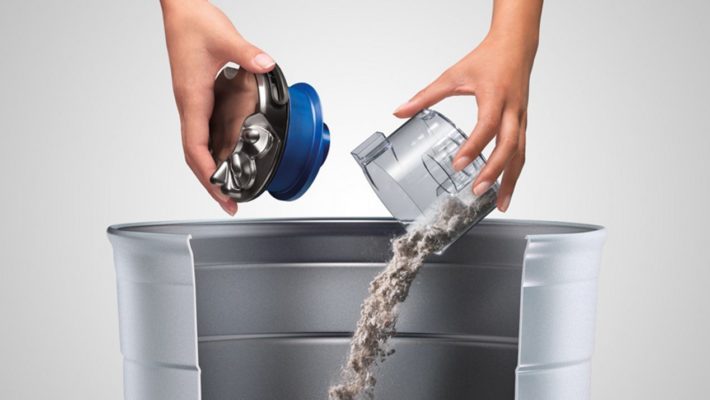
Keeping up with the maintenance of your robotic vacuum is of paramount importance. You should have a regular schedule of things such as battery checks, clogs, emptying the dustbins, checking the extractors for tangles and general cleaning.
The 360 Eye has a much smaller collection bin than the Roomba 980, half the size, in fact. You will be required to empty it a lot more often. Many reports from other happy uses indicate that the collection bin doesn’t always get full before needing to be emptied. Pet hair will ball up and collect in the corners, resulting in a full indication, even though there is plenty of room left in the container.
The Roomba 980 will also fill after so many uses. In general, owners report having to empty the collection bin every third or fourth cycle, depending on factors such as pet hair and size of the cleaning area.
The collection bins are pretty easy to remove and empty, although the Dyson bin does take a bit to get unlocked.
Other things to check weekly include the extractor bars. Keeping them clear of tangles and debris is crucial to the functionality of the vacuum. Removing them bars and clearing them off is a simple task for the Roomba 980. You wipe them clean and reattach, and you are good to go. Once you learn the process, you can complete the cleaning and maintenance in about 15 minutes. The Dyson 360 Eye will take you about 20 to 30 minutes.
Bottom Line: This is a tie. Regular check-ups and maintenance are a critical step in all robotic vacuum ownership and should be done regularly.
Frequently Asked Questions
Now that we know a little more about the features and options, I will answer some of the more common questions about the two robots.
Q. Will it go under the bed even if there is a bed skirt?
A. In the case of the Roomba, the answer is maybe. In the case of the Dyson however, the answer is maybe.
Both rely on visual camera sensors to navigate the area. When the camera senses an obstacle, it will slow down until there is physical resistance. The Roomba will go through most bed skirts and low hanging window dressings as they are not heavy enough to trip the touch sensors.
The 360 Eye will probably not go under the bed as it relies on light for the camera to update. If it is too dark, even pushing through the bed skirt, it may decide it is too dark to navigate and skip it.
You can always tuck your bed skirt up until the cleaning is done, provided there is enough light to maneuver under your bed.
Q. We have a lot of abnormal pets, will either of these pick up strange bedding such as cedar chips and straw?
A. You shouldn’t call your pets abnormal; they may develop a complex. I will assume you have rabbits or chinchillas and are not keeping your horses in the house. The Roomba will pick up chips and straw as long as the pieces aren’t too oversized. It will handle cereal such as fruit rings without problem.
The 360 Eye will also pick up these items; however, it’s collection bin sensor is very sensitive. One long piece of straw can trigger the sensor into thinking the bin is full.
Q. Is this an allergy-free vacuum?
A. No. The Dyson 360 Eye has a dairy intolerance and will break out in hives if it has any dairy at all. The Roomba is allergic to all manner of nuts. Don’t let them attend your parties!
I assume you are talking about allergen filtration. HEPA filters are the only filters certified as allergen filters. To qualify as a HEPA, they must capture particles down to 0.3 microns in size. The Roomba 980 only uses HEPA filtration.
Dyson does not classify their filters as HEPA; however, it should be noted that their filters are able to collect particles down to 0.1 microns, so in effect, they are HEPA rated. I don’t believe HEPA certifications exist in Germany, which may be why they lack the label.
Q. What comes in the box when you buy these machines?
A. The Dyson 360 Eye will come with the docking station, the charging cors, the 360 Eye itself, and the owners manual.
The Roomba 980 will come with the 980 model, the charging station, power cord, two extra side brushes, an extra HEPA filter, two virtual wall barriers (and their batteries), and the owners manual.
Q. Do these things really work, like, really?
A. No. There is actually nothing in the box; it is one large scam just to take all of your money from only you.
In truth, there have been several tests done on each of these vacuums. The results are pretty clear. With a powerful motor and rotating brushes, the Dyson will vacuum floors and carpets. However, it will leave a lot to be desired. It will miss a lot of debris, and in one test on a popular television morning show, it didn’t pick up any dry rice.
The Roomba also has three-stage cleaning and carpet boost technology. However, that being said, it still underperforms what Roomba owners have become used too. It will clean well, and it doesn’t miss a lot, but compared to some of the earlier models with fewer features, it doesn’t do as good of a job as it should.
Side by side, running over the exact same flooring at the exact same time, the Roomba will out clean the Dyson every time.
Q. Will it work on shag carpeting or will it get tangled?
A. Welcome to the future my hippie friend. Yes, both machines will traverse and clean shag carpeting. In fact, the 980 will do a better job on shag carpeting than most other vacuums of any style. The Dyson 360 Eye can get snagged on long pile shag such as that found in the early 1960s, but the shorter shag of the late 1970s and ‘80s (that for some reason is still around today) should pose no problems.
Q. The 360 Eye looks really tall for a robot vacuum, will it go under furniture?
A. If the furniture is high enough, it will. A lot of factors go into how well the robot vacuums with cameras operate under furniture or if they even go under in the first place. Yes, the height is important, but also lighting and other items that may be under the couch.
The camera sensors need light to work, and if you turn off all your lights, neither vacuum will be able to “see” and won’t clean very well, if at all. This includes under furniture. If it is too dark, it won’t even try. The 360 Eye, though, to specifically answer your question is 4.72 inches in height and will need another half to full inch clearance. If your furniture is not at least five and a half inches off the ground, the robot won’t go under it.
Q. You didn’t mention Dyson 360 Eye Quiet Mode.
A. You didn’t ask a question. Quiet mode is a setting on the 360 Eye that will prolong the battery life by making the vacuum use less suction. In normal mode, the decibel rating is just about 57db, which is just about as loud as your alarm clock or hair dryer. In quiet mode the decibels are reduced to about 45 with is about as loud as a normal conversation in a restaurant.
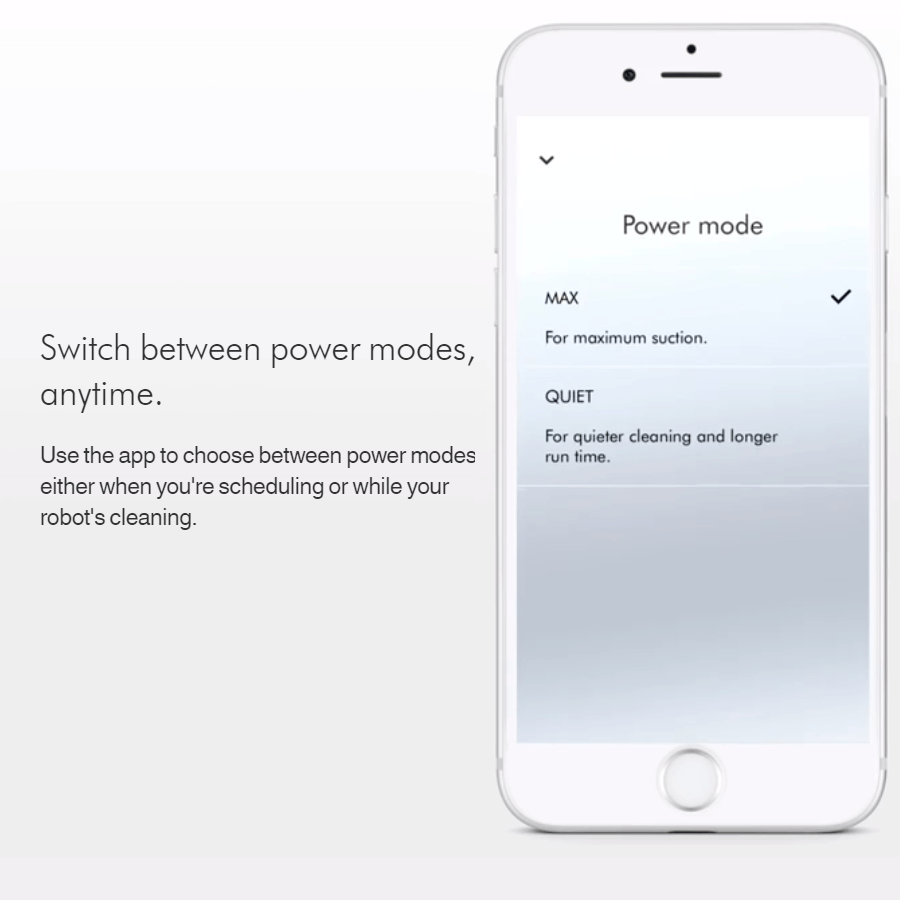
There isn’t much difference in the modes except for a loss of suction, which will result in you not using the quiet mode, which is why it wasn’t mentioned before now.
What I Like About the Dyson 360 Eye
- High powered motor and increased suction (even in the dreaded quiet mode)
- Constant navigational updating with 30 images per second.
- Full-width brush bar for wider angle coverage.
- Doesn’t collide with objects very often.
- Tank Tracks make mobility a non-issue.
- It looks like a battle bot.
What I like About the Roomba 980
- Visual camera sensors for added navigation aid.
- The ihome app is very user-friendly.
- Dirt detection sensors ensure a thorough clean.
- Entire level cleaning even after a recharge is needed.
- Extra long battery life and runtime.
In Conclusion
The battle of the robot vacuums will continue on. New models will come out with new features and options and eventually there will be a clear winner. Today is not that day.
The Dyson 360 Eye has advanced visual technology that makes it the best robot vacuum in terms of navigation and mapping. It won’t collide with objects and furniture near as much as the competition. However, it is taller and will not get in as many places as some of the smaller vacuums.
To block its path you will have to shut doors or put up barricades. Providing this isn’t an issue you have the Dyson name and up to a five-year warranty to back the machine. It does leave a bad taste in my mouth for the level of clean is does not do. However, as part of a regular cleaning program, the floors can stay clean with regular use.
The iRobot Roomba 980 has also dropped the ball when it comes to overall performance. Some of the earlier series vacuums cleaned a lot better. However, the 980 does make sure it picks up as much as possible and does a fairly decent job. The camera navigation is a lot better than expected, and it doesn’t have as much difficulty finding its docking station as previous models did.
Comparing the two against each other though, I would pay for the Roomba 980 before I ever considered the Dyson 360 Eye. The added features, extra sensors, and longevity of the reliable brand still mean something and its performance is still top notch. Dyson makes great products; however, the robot vacuum 360 Eye is not their best effort to date.
Click here for all the robot vacuum deals on Amazon today.
